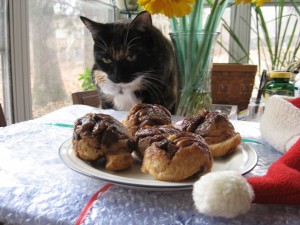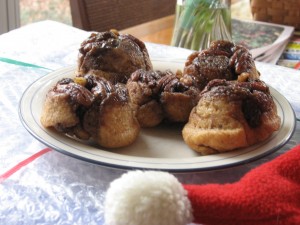
Ben Pollock photo
My Reform Jewish family in Fort Smith, Arkansas, had schnecken for breakfast every Christmas. There was no recipe so every December in adulthood I’ve tried to recreate the childhood memory, with cookbooks, recollections of family and improvising. That was starting in my 20s. In my 30s, I also began cooking healthier. These cannot honestly be made without butter and sweeteners, I’ve found, but some whole wheat flour heightens the flavor. The last and longest step has been to increase the efficiency of the recipe as it is cumbersome, as well as keeping the quality consistent. I think this is it.
Schnecken, the Internet says, is German for snail, and it’s the Yiddish expression for the spiral, snail shell-like shape. For everyone not inclined to schmooze online, schnecken are essentially the same as what often are called sticky buns or caramel-pecan rolls, generally with raisins as well. All are cooked upside-down, the dough placed atop a glaze and baked, then inverted to serve. My family’s apparently were baked in muffin tins, not a jelly roll pan, so that’s what I do. The smaller size controls the calories, sort of.
The following is not a recipe for bread-baking novices. It’s not sophisticated, just several stages to go through. Any good bread book will have a multigrain challah or brioche dough; prepare as directed, until you get to the stage of final shaping.
A hint on sweeteners used here: Light brown sugar and light corn syrup provide a somewhat lighter texture and lighter color. Dark brown sugar and dark corn syrup provide more of a molasses flavor.
Dough
About 2 pounds of any challah or brioche “enriched” yeast dough, preferably one including whole wheat. Bakers call a bread enriched when it includes eggs, dairy and/or a sugar. A 2-pound loaf is one that starts with around 4 cups of flour. (See updated credits at bottom.)
Cinnamon-Sugar Filling
- 3/4 cup packed brown sugar (light or dark)
- 2 teaspoons ground cinnamon
- 1/4 teaspoon ground cloves (4 whole cloves)
- 1/4 teaspoon salt
- 1 cup raisins, plumped overnight in refrigerator in water, orange juice, wine or bourbon to cover, then drained
- 1 cup pecans, coarsely chopped. Lightly toasted is optional.
- 2 tablespoons butter, melted
- 2 tablespoons milk
- 1 teaspoon vanilla
Caramel Glaze
- 6 Tablespoons unsalted butter
- 3/4 cup packed brown sugar (light or dark)
- 3 Tablespoons corn syrup (light or dark)
- 2 tablespoons cream OR eggnog OR half and half OR as, last resort, milk
- 1/4 teaspoon salt
- 1 teaspoon vanilla
- 60-72 pecan halves, about 2 cups. Lightly toasted is optional.
Fillings: Combine brown sugar, cinnamon, cloves, and salt in small bowl and mix until thoroughly combined, breaking up sugar lumps. (If using whole cloves, grind in coffee grinder first with cinnamon and salt.) In another small bowl, combine milk, butter and vanilla.
Glaze: Combine all ingredients for glaze — except vanilla and pecan halves — in small saucepan; cook over medium heat, whisking occasionally, until butter is melted and mixture is thoroughly combined. Turn off heat, stir in the vanilla and leave on burner to stay warm.
Turn dough out onto a lightly floured, large carving board, about 18 by 24 inches in size. Roll out dough to about 18 by 24 inches, to 1/4 to 1/2 inch thick. If the dough resists, wait five minutes and go again. Add just a little flour to either side to prevent sticking.
Brush the butter-and-milk mixture over dough, leaving dry a half-inch border along all four edges. Sprinkle all the cinnamon-sugar over the butter-milked area. Sprinkle drained, plumped raisins over that. Sprinkle the nuts over that.
Beginning with a long edge, roll dough into a tight cylinder. Pinch seam and ends to seal, and roll cylinder to be seam-side down. Let rest a few moments as you prepare the tins.
Grease 24-36 muffin tin cups with shortening, butter or spray-oil, even if the pans are non-stick. Spoon about 1 Tablespoon of the glaze into each muffin cup; rest 2 pecan halves in the glaze of each muffin cup.
With a serrated knife, slice off half-inch rounds. Pull out and lengthen the remaining cylinder between every few cuts. Place each slice in prepared muffin cup. (It is OK to cut a few slices into quarters and place those pieces atop the smaller slices, or on the end slices that don’t have as many raisins and nuts. Otherwise, do not waste time trying to make the muffins the same size. Their sizes will be close enough once they rise.)
When the muffin tin is full-up, spritz spray-oil and cover loosely with plastic wrap. Then fill the next tin with slices. Spritz those buns with spray-oil and cover with plastic wrap.
 Set in warm, draft-free spot. After 30-45 minutes, turn on the oven to 350 degrees to preheat 30 minutes. (A baking stone on the lowest rack is recommended.) Total rising time is 1 to 1 1/4 hours; the rolls will be puffy and rise just a little above the level on their tin. Remove plastic wrap and place tins on two racks in oven. Bake 15 minutes then reverse position of tins and bake another 10-15 minutes, until the tops are golden brown.
Set in warm, draft-free spot. After 30-45 minutes, turn on the oven to 350 degrees to preheat 30 minutes. (A baking stone on the lowest rack is recommended.) Total rising time is 1 to 1 1/4 hours; the rolls will be puffy and rise just a little above the level on their tin. Remove plastic wrap and place tins on two racks in oven. Bake 15 minutes then reverse position of tins and bake another 10-15 minutes, until the tops are golden brown.
Cool on wire racks 5 minutes. Using 1-2 small spoons, gently but quickly remove each schnecken to a plate or wire rack covered with a sheet of wax paper. The hot glaze can burn fingers! Scoop out any glaze that remains in each cup and smooth back onto the pastry’s top, centering the pecans.
Serve immediately. Alternately, cool to room temperature and store covered, rolls separated by wax paper, at room temperature, for up to two days. Schnecken freeze well. They can be warmed in the oven, first removing the wax paper and wrapping in foil; Mom would put a dab of butter on each first.
Credits (Updated December 2013): My first source is Sunset Breads by Sunset Publishing. The dough I’ve used in recent years is half of the recipe of “Braided Challah with Whole Wheat and Wheat Germ” from Healthy Bread in Five Minutes a Day by Jeff Hertzberg, M.D., and Zoe Francois. The glaze and filling are adapted from the “Sticky Buns with Pecans” recipe in the September 2004 issue of Cooks Illustrated. (December 2014: Here is my dairy- and egg-free version, “Snack on Vegan Schnecken.”)

3 replies on “Savor Schnecken Like a Snail”
From Janet, via Facebook:
I love sticky buns!
From Bill, via Facebook:
You may have all my life’s supply of schnecken, Ben, if we’re talking real snails. But if we’re into pastries, you have to share.
Schnecken will be gone by lunchtime Monday [Dec. 27]. Join us. After noon, we’ll be supping on lettuce and water.